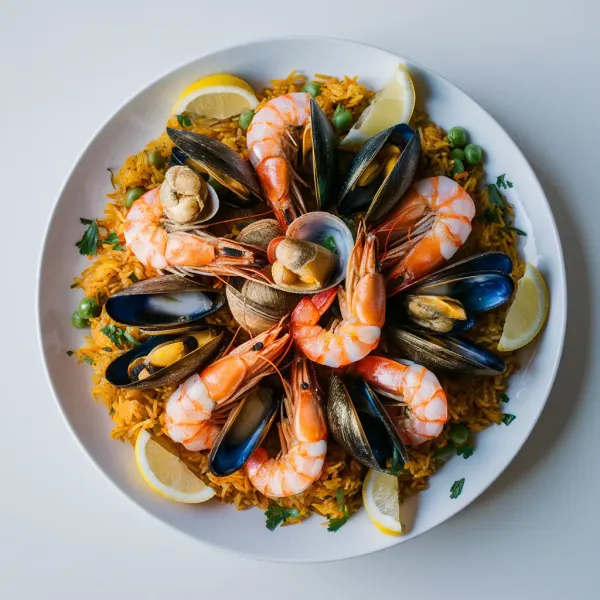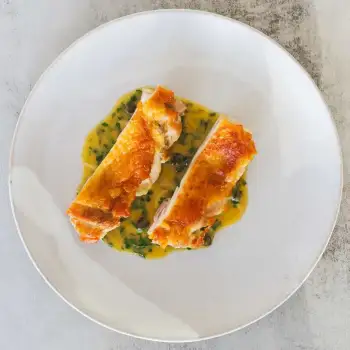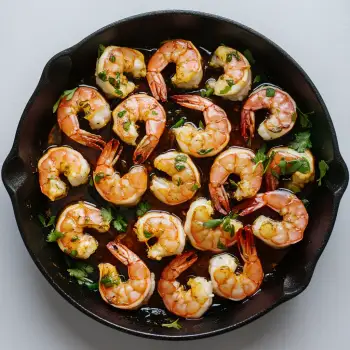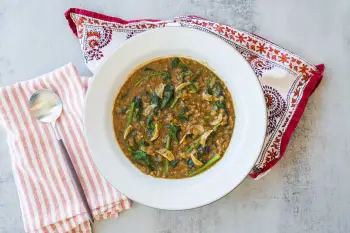
 50 minutes
50 minutesA delightful combination of baby potatoes, chorizo, and fresh shellfish in a creamy, aromatic broth. Perfect for a seaside-inspired meal.


Baby potatoes, unpeeled, halved if larger than 1 inch
0 lb
to taste
to taste
tablespoons
tablespoons
Yellow Onion, chopped
cups
Garlic, minced
cloves
Spanish-Style Chorizo, halved lengthwise and sliced ½ inch thick
0 oz
Fresh Tarragon Leaves, minced
tablespoons
cups
cups
Sea Scallops, side muscles removed, halved
0 lb
Littleneck Clams, scrubbed
0 lb
Mussels, scrubbed and debearded
0 lb
Flat Leaf Parsley, minced
tablespoons
Crusty Baguette
each
1. Cook the potatoes
Place the baby potatoes in a medium saucepan, cover them with water, and add a generous pinch of kosher salt. Bring the water to a boil and cook the potatoes for 8-10 minutes until they are barely tender. Drain the potatoes and set them aside.
2. Sauté onions
In a large stockpot or Dutch oven, melt 2 tablespoons of unsalted butter along with 1 tablespoon of olive oil over medium-low heat. Once the butter has melted, add 2 cups of chopped yellow onion and sauté for 7-10 minutes until the onions are soft and translucent but not browned.
3. Add garlic and chorizo
Add 1 tablespoon of minced garlic and 4 ounces of sliced chorizo to the pot. Sauté for another 5-7 minutes, allowing the garlic to release its aroma and the chorizo to render some of its fat and flavor.
4. Infuse with tarragon
Stir in 1 tablespoon of minced fresh tarragon leaves, and let it cook for about a minute to infuse the mixture with its delicate anise flavor.
5. Add wine and reduce
Pour in 1.5 cups of dry white wine, such as Chablis or Pinot Grigio, and bring it to a simmer. Allow the wine to reduce by half, which will take about 5-7 minutes. This step is crucial as it concentrates the flavors, creating a rich base for the dish.
6. Add cream and potatoes
Next, add 1.5 cups of heavy cream to the pot, followed by the reserved potatoes, a pinch of kosher salt, and a few grinds of freshly ground black pepper. Let the mixture cook for 4-5 minutes until it begins to thicken slightly.
7. Add shellfish
Gently stir in the halved sea scallops, then add the clams and mussels to the pot. Cover the pot and let the shellfish simmer for 8-10 minutes, or until the shells have opened up.
8. Adjust seasoning and serve
Taste the mixture to adjust the seasoning if necessary, then ladle the medley into large shallow bowls. Sprinkle each serving generously with minced fresh parsley. Serve hot, accompanied by chunks of crusty baguette.
Replace the chorizo with a mild Italian sausage, add more tomato to the broth, and incorporate a variety of fish and shellfish such as cod, clams, and mussels. Use fennel alongside the aromatics for a more complex flavor profile.
This is a traditional French seafood stew. You can omit the chorizo and use saffron, orange zest, and fennel for a Provençal flavor. Seafood can include anything from sea bass to monkfish and traditional rouille on the side.
Use the chorizo and shellfish as the protein but cook it with saffron-infused short-grain rice, adding in vegetables like peas and roasted red peppers. The cooking method shifts to a more passive, rice-focused dish.
Swap out the traditional herbs for a blend of curry spices, and use coconut milk as part of the cooking liquid. This variation would work well with a mix of shellfish and firmer white fish.
Use the chorizo and shellfish, but serve it over pasta with a sauce made from the cooking liquid, bolstered by olives, capers, and a hit of chili flakes.
Add shellfish in order of cook time—clams first, then mussels, then shrimp. Remove from heat once they’re cooked to avoid toughness.
Ensure the clams, mussels, and shrimp smell ocean-fresh and for mussels and clams, have closed shells. Opt for freshly made chorizo if possible.
Serve immediately with crusty bread to avoid overcooking the shellfish in residual heat.
Pick a chorizo that suits your taste—spicy, sweet, smoked, or unsmoked. Thinly slice it to cook evenly and infuse the dish with flavor.
A wide, shallow pan is best for even cooking and to prevent overcrowding of the shellfish.




Comments (0)